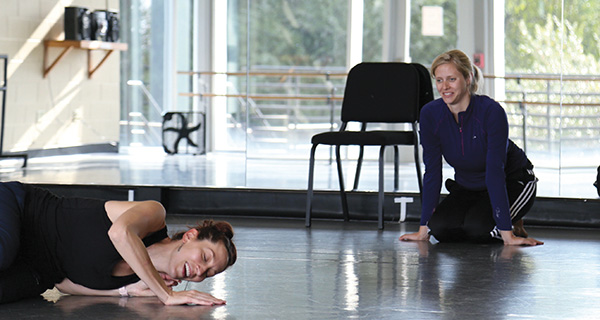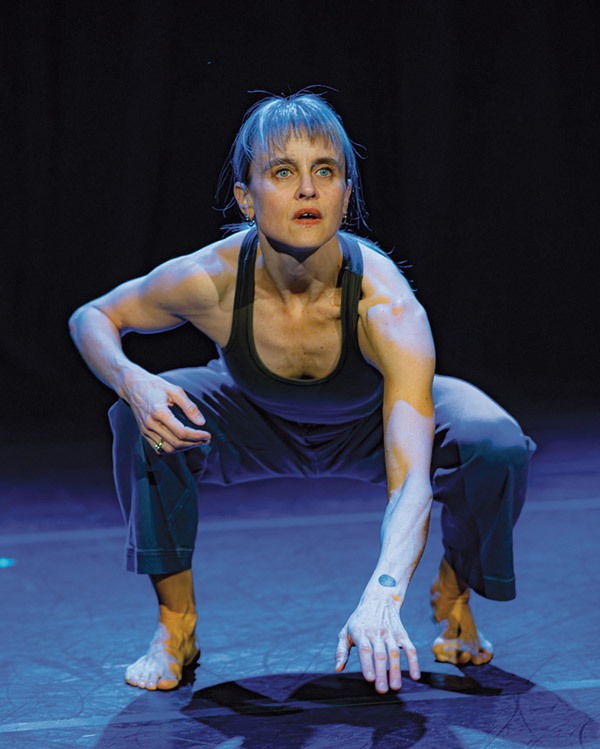american / woman project

Betsy Miller’s american / woman project begins with a fundamental question: what does it mean to be a woman? Doubling down, Miller adds, what does it mean to be a woman in America? She directs her questions to at least one female-identifying dancer from each of the fifty states and together with them, creates a kinesthetic biography of sorts for each dance artist.
“It’s the boldest idea I ever had,” says Miller, an associate professor of dance and music at Salem State University and the 2023 Bates Dance Festival artist in residence.
“Traditionally the dancer is seen as an instrument for the vision of the choreographer. The dancer has no agency in that relationship. As a choreographer, it is my job to facilitate a dance work experience centered on their interests and identities that serves no greater purpose than to platform the artist,” explains Miller. Adding, “It’s a very humanistic way to make art.”
Since the project began in 2018, she has covered over half of her territory creating twenty-nine dance performances. The process begins with Miller asking each dancer a series of questions designed to reveal how they see themselves as a woman, artist, and an American. While many responses weave webs of relationships to both the people and the work that defines them—motherhood, sisterhood, creator, collaborator, fighter, and friend—Miller says it is the “American” question that unearths the most diverse answers. “It’s a huge mix of shame, anger, frustration, pride, and gratitude.” There are regional differences as well. “The closer they were to the coast, they were more angsty.” The Midwestern dancers acknowledge a greater sense of privilege at being an American than their coastal counterparts, says Miller.
A few of the dancers have performed multiple times for the project since its inception, updating and tweaking their performances to reflect the evolution in their lives.
That was especially true for the head of physical theatre for the Brown/Trinity Rep MFA Programs for Actors and Directors and Brown University assistant professor Shura Baryshnikov. Representing Rhode Island, and friends with Miller for many years, she was one of the first dancers to sign onto the american / woman project. At the time, Baryshnikov still had two teenage children at home. Consequentially, she says, “A lot of the theme was talking about my fear as a mom because of all the public school shootings. They are both in college now and those fears haven’t gone away, but the immediacy for my concerns has.”
Her composition for the project is titled a few things on my mind and it debuted at the dance center Movement Arts Gloucester, or MAGMA. In a video of the performance, Baryshnikov wears black shorts and a white button-down shirt. Her hair is pulled back in a simple ponytail. The only acoustic accompaniment at first is the sound of Baryshnikov’s bare feet sliding across the wood floor as she performs both improvised and set movements. About two minutes into the work, she breaks the tension by reciting the first line of an autobiographical poem saying, “I know something about muscular tone.” The audience responds with a nervous laugh. Baryshnikov ends each successive phrase beginning “I know something about,” with novel, often charming and sometimes heart-breaking revelations like “tenderness, making soup, removing berry stains, daughters, divorce, and depression.” As the daughter of Mikhail Baryshnikov, one of the preeminent male dancers in the history of ballet, and two-time Academy Award-winning actress Jessica Lange, she also knows something about celebrity and says so in her poem.
In a separate interview when asked about the impact her parents have on her she says, “Over my life as a creative person, and a person, I had to stand on my feet and find my own value and do projects that I find interesting. I can’t live in comparison to them.”

Nearing the end of the poem, Baryshnikov says “I know something about sitting in a car watching a child walk into a school building.” Then she crouches briefly before dancing to the text from a 1951, cold-war era film detailing the technique for the Duck and Cover position that school children were instructed to assume in the event of a nuclear bomb explosion. “Be sure to cover your face and neck. You could be burned far worse than any sunburn you’ve ever had,” warns a bizarrely cheery narrator. Once the voice over finishes, Baryshnikov lies supine on the ground for nearly forty seconds. She begins dancing again to her own voice singing in a gentle soprano the lyrics of Bob Dylan’s Make You Feel My Love. The final moments of the nine-minute performance are in darkness and again, near silence, the only audible sounds are Baryshnikov’s breath and steps as she dances unseen by the audience.
In the preparation for the project Baryshnikov tells Miller in a voice memo, “I value the depth of my physicality. What it has been to be a mother: pregnancy, labor and delivery, parenting of young children and overcoming physical hardship and injury. This beautiful groundedness that emerges from having to be resilient and push through fatigue, discomfort, and pain at times.”

The artistic output of the dancer representing Massachusetts, Ali Kenner Brodsky, an award-winning choreographer and filmmaker, typically echoes the poignancy of Baryshnikov’s performance. “The work I make is centered on loss and memory, moving through grief,” says Kenner Brodsky.
She and Miller had also been friends for years when they began working on her solo. At the time, she had been grieving her mother whom she lost to cancer the previous year. So, when Miller asked what she wanted to make, Kenner Brodsky saw an opportunity for a much-needed emotional breather.
“Let’s make something fun,” she remembers saying. In pursuit of that vibe, she struts onto the stage for her work titled alter / ego. Her bracelet sparkles under the fuchsia lighting bathing the stage and a lock of her close-cropped, black hair dangles over one eye. For the next four minutes Kenner Brodsky channels her inner “twelve-year-old” in a dance replent with upbeat, jazz moves, come-hither eye contact, and even a seemingly impromptu water break to the accompaniment of a 1974 funk tune April Fool by Jean Fineberg.
In November 2023 Kenner Brodsky revisited the piece, along with other New England dancers, in a performance of the project supported by Motion State Arts, an organization she cofounded that produces dance films and live performance.
“I discovered new things about it, but it still resonates with me. For me, it’s pure fun and a way of dancing that I don’t normally get to do.
I am not a jazz dancer. I never was. This piece lets me let loose a little bit,” says Kenner Brodsky.
The response to the project has been overwhelmingly positive and is funded through multiple vehicles including the New England Foundation for the Arts, Salem State University, Next Steps for Boston Dance, the Boston Foundation, and individual donors. Miller says many of the dancers find the experience therapeutic using the process as a “safe container” to explore and a creative path that reconnects them to their “dance bliss.”
For Miller, the project added an unexpected yet welcome dimension to her practice: “Maybe it’s because of the project but I was interested in making dances that were the most brilliantly crafted works of art…and using dance to make sense of the world. Now I can also use dance as a means to empower people and that is what I love about dance.”
